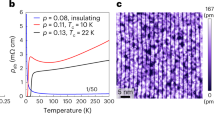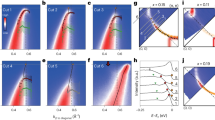Abstract
As doping increases in cuprate superconductors, the superconducting transition temperature increases to a maximum at the so-called optimal doping, and then decreases in the overdoped regime. In the past few decades, research has primarily focused on the underdoped and optimally doped regions of the phase diagram. Here, phenomena such as the pseudogap and strange metal non-superconducting states make it difficult to determine the superconducting pairing mechanism. More recently, experiments have shown unconventional behaviour in strongly overdoped cuprates, in both the normal and superconducting states. However, a real-space investigation of the unconventional superconductivity in the absence of the pseudogap is lacking, and the superconductor-to-metal phase transition in the overdoped regime remains controversial. Here we use scanning tunnelling microscopy to investigate the atomic-scale electronic structure of overdoped Bi2Sr2Can − 1CunO2n + 4 + δ cuprates. We show that, at low energies, the spectroscopic maps are well described by dispersive d-wave quasiparticle interference patterns. However, as the bias increases to the superconducting coherence peak energy, a periodic and non-dispersive pattern emerges. The position of the coherence peaks exhibits particle–hole asymmetry that modulates with the same period. We propose that this behaviour is due to quasiparticle interference caused by pair-breaking scattering between flat antinodal Bogoliubov bands.
This is a preview of subscription content, access via your institution
Access options
Access Nature and 54 other Nature Portfolio journals
Get Nature+, our best-value online-access subscription
$29.99 / 30 days
cancel any time
Subscribe to this journal
Receive 12 print issues and online access
$209.00 per year
only $17.42 per issue
Buy this article
- Purchase on Springer Link
- Instant access to full article PDF
Prices may be subject to local taxes which are calculated during checkout





Similar content being viewed by others
Data availability
The data used to support the findings of this work are available from the corresponding author upon request. Source data are provided with this paper.
References
Cooper, R. A. et al. Anomalous criticality in the electrical resistivity of La2 − xSrxCuO4. Science 323, 603–607 (2009).
Vignolle, B. et al. Quantum oscillations in an overdoped high-Tc superconductor. Nature 455, 952–955 (2008).
Plate, M. et al. Fermi surface and quasiparticle excitations of overdoped Tl2Ba2CuO6 + δ. Phys. Rev. Lett. 95, 077001 (2005).
Hashimoto, M., Vishik, I. M., He, R.-H., Devereaux, T. P. & Shen, Z.-X. Energy gaps in high-transition-temperature cuprate superconductors. Nat. Phys. 10, 483–495 (2014).
Zhong, Y. G. et al. Continuous doping of a cuprate surface: insights from in situ angle-resolved photoemission. Phys. Rev. B 98, 140507 (2018).
Matsui, H. et al. BCS-like Bogoliubov quasiparticles in high-Tc superconductors observed by angle-resolved photoemission spectroscopy. Phys. Rev. Lett. 90, 217002 (2003).
Rourke, P. M. C. et al. Phase-fluctuating superconductivity in overdoped La2 − xSrxCuO4. Nat. Phys. 7, 455–458 (2011).
Kondo, T. et al. Point nodes persisting far beyond Tc in Bi2212. Nat. Commun. 6, 7699 (2015).
Peng, Y. Y. et al. Re-entrant charge order in overdoped (Bi,Pb)2.12Sr1.88CuO6 + δ outside the pseudogap regime. Nat. Mater. 17, 697–702 (2018).
Wu, J., Bollinger, A. T., He, X. & Bozovic, I. Spontaneous breaking of rotational symmetry in copper oxide superconductors. Nature 547, 432–435 (2017).
Kurashima, K. et al. Development of ferromagnetic fluctuations in heavily overdoped (Bi,Pb)2Sr2CuO6 + δ copper oxides. Phys. Rev. Lett. 121, 057002 (2018).
Dean, M. P. M. et al. Persistence of magnetic excitations in La2 − xSrxCuO4 from the undoped insulator to the heavily overdoped non-superconducting metal. Nat. Mater. 12, 1018–1022 (2013).
Bozovic, I., He, X., Wu, J. & Bollinger, A. T. Dependence of the critical temperature in overdoped copper oxides on superfluid density. Nature 536, 309–311 (2016).
Mahmood, F., He, X., Božović, I. & Armitage, N. P. Locating the missing superconducting electrons in the overdoped cuprates La2 − xSrxCuO4. Phys. Rev. Lett. 122, 027003 (2019).
Li, H. et al. Coherent organization of electronic correlations as a mechanism to enhance and stabilize high-Tc cuprate superconductivity. Nat. Commun. 9, 26 (2018).
He, Y. et al. Superconducting fluctuations in overdoped Bi2Sr2CaCu2O8 + δ. Phys. Rev. X 11, 031068 (2020).
Fischer, Ø., Kugler, M., Maggio-Aprile, I., Berthod, C. & Renner, C. Scanning tunneling spectroscopy of high-temperature superconductors. Rev. Mod. Phys. 79, 353–419 (2007).
Hoffman, J. E. et al. Imaging quasiparticle interference in Bi2Sr2CaCu2O8 + δ. Science 297, 1148–1151 (2002).
Wang, Q. H. & Lee, D. H. Quasiparticle scattering interference in high-temperature superconductors. Phys. Rev. B 67, 020511 (2003).
Hanaguri, T. et al. Quasiparticle interference and superconducting gap in Ca2 − xNaxCuO2Cl2. Nat. Phys. 3, 865–871 (2007).
Fujita, K. et al. Bogoliubov angle and visualization of particle–hole mixture in superconductors. Phys. Rev. B 78, 054510 (2008).
Hanaguri, T. et al. A ‘checkerboard’ electronic crystal state in lightly hole-doped Ca2 − xNaxCuO2Cl2. Nature 430, 1001–1005 (2004).
Parker, C. V. et al. Fluctuating stripes at the onset of the pseudogap in the high-Tc superconductor Bi2Sr2CaCu2O8 + x. Nature 468, 677–680 (2010).
Kohsaka, Y. et al. An intrinsic bond-centered electronic glass with unidirectional domains in underdoped cuprates. Science 315, 1380–1385 (2007).
Hoffman, J. E. et al. A four unit cell periodic pattern of quasi-particle states surrounding vortex cores in Bi2Sr2CaCu2O8 + δ. Science 295, 466–469 (2002).
Drozdov, I. K. et al. Phase diagram of Bi2Sr2CaCu2O8 + δ revisited. Nat. Commun. 9, 5210 (2018).
He, Y. et al. Fermi surface and pseudogap evolution in a cuprate superconductor. Science 344, 608–611 (2014).
Fujita, K. et al. Simultaneous transitions in cuprate momentum-space topology and electronic symmetry breaking. Science 344, 612–616 (2014).
Valla, T., Drozdov, I. K. & Gu, G. D. Disappearance of superconductivity due to vanishing coupling in the overdoped Bi2Sr2CaCu2O8 + δ. Nat. Commun. 11, 569 (2020).
Jenkins, N. et al. Imaging the essential role of spin fluctuations in high-Tc superconductivity. Phys. Rev. Lett. 103, 227001 (2009).
Zou, C. et al. Effect of structural supermodulation on superconductivity in trilayer cuprate Bi2Sr2Ca2Cu3O10 + δ. Phys. Rev. Lett. 124, 047003 (2020).
Hao, Z. et al. Anomalous doping evolution of superconductivity and quasiparticle interference in Bi2Sr2Ca2Cu3O10 + δ trilayer cuprates. Phys. Rev. Lett. 125, 237005 (2020).
McElroy, K. et al. Atomic-scale sources and mechanism of nanoscale electronic disorder in Bi2Sr2CaCu2O8 + δ. Science 309, 1048–1052 (2005).
Hanaguri, T. et al. Coherence factors in a high-Tc cuprate probed by quasi-particle scattering off vortices. Science 323, 923–926 (2009).
Sprau, P. O. et al. Discovery of orbital-selective Cooper pairing in FeSe. Science 357, 75–80 (2017).
Gu, Q. et al. Directly visualizing the sign change of d-wave superconducting gap in Bi2Sr2CaCu2O8 + δ by phase-referenced quasiparticle interference. Nat. Commun. 10, 1603 (2019).
Kohsaka, Y. et al. How Cooper pairs vanish approaching the Mott insulator in Bi2Sr2CaCu2O8 + δ. Nature 454, 1072–1078 (2008).
He, R.-H. et al. From a single-band metal to a high-temperature superconductor via two thermal phase transitions. Science 331, 1579–1583 (2011).
Li, X. et al. Quasiparticle interference and charge order in a heavily overdoped non-superconducting cuprate. N. J. Phys. 20, 063041 (2018).
Miao, H. et al. Charge density waves in cuprate superconductors beyond the critical doping. npj Quantum Mater. 6, 31 (2021).
Zeljkovic, I. et al. Imaging the impact of single oxygen atoms on superconducting Bi2 + ySr2 − yCaCu2O8 + x. Science 337, 320–323 (2012).
Vishik, I. M. et al. A momentum-dependent perspective on quasiparticle interference in Bi2Sr2CaCu2O8 + δ. Nat. Phys. 5, 718–721 (2009).
Li, H. et al. Four-legged starfish-shaped Cooper pairs with ultrashort antinodal length scales in cuprate superconductors. Preprint at https://arxiv.org/abs/1809.02194 (2018).
Li, Z.-X., Kivelson, S. A. & Lee, D.-H. Superconductor-to-metal transition in overdoped cuprates. npj Quantum Mater. 6, 36 (2021).
Liang, B., Bernhard, C., Wolf, T. & Lin, C. T. Phase evolution, structural and superconducting properties of Pb-free Bi2Sr2Ca2Cu3O10 + δ single crystals. Supercond. Sci. Technol. 17, 731–738 (2004).
Piriou, A., Fasano, Y., Giannini, E. & Fischer, O. Effect of oxygen-doping on Bi2Sr2Ca2Cu3O10 + δ vortex matter: crossover from electromagnetic to Josephson interlayer coupling. Phys. Rev. B 77, 184508 (2008).
Vincini, G. et al. Double pair breaking peak in Raman scattering spectra of the triple-layer cuprate Bi2Sr2Ca2Cu3O10 + z. Phys. Rev. B 98, 144503 (2018).
Ye, C. et al. Visualizing the atomic-scale electronic structure of the Ca2CuO2Cl2 Mott insulator. Nat. Commun. 4, 1365 (2013).
Lawler, M. J. et al. Intra-unit-cell electronic nematicity of the high-Tc copper-oxide pseudogap states. Nature 466, 347–351 (2010).
Acknowledgements
We thank T. K. Lee, T. Li, Q. H. Wang, Z. Y. Weng and T. Xiang for helpful discussions. This work was supported by the Basic Science Center Project of NSFC under grant no. 51788104, the MOST of China (grants nos. 2017YFA0302900 and 2016YFA0300300), NSFC grants nos. 11888101 and 11534007, and the Strategic Priority Research Program (B) of the Chinese Academy of Sciences (XDB25000000). D.-H.L. was supported by the US Department of Energy, Office of Science, Basic Energy Sciences, Materials Sciences and Engineering Division, contract no. DE-AC02-05-CH11231 within the Quantum Materials Program (KC2202). D.-H.L. also acknowledges support from the Gordon and Betty Moore Foundation’s EPIC initiative (grant no. GBMF4545). This work is supported in part by the Beijing Advanced Innovation Center for Future Chip (ICFC) and the Tencent Foundation.
Author information
Authors and Affiliations
Contributions
C.Z., Z.H. and Y.W. proposed and designed the research. C.Z., Z.H. and M.X. carried out the STM experiments. C.Z. analysed the data with help from Z.H., P.C., S.Y. and X. Li. C.L. provided the Bi-2223 single crystals. X. Luo and X.Z. performed high-pressure oxygen annealing of Bi-2223 samples. Q.G. and X.Z. grew the Bi-2212 single crystals and performed the post-annealing. D.-H.L. provided theoretical analysis. C.Z., D.-H.L. and Y.W. prepared the manuscript. All authors have read and approved the final version of the manuscript.
Corresponding author
Ethics declarations
Competing interests
The authors declare no competing interests.
Peer review
Peer review information
Nature Physics thanks José Lorenzana, Mohammad H. Hamidian and the other, anonymous, reviewer(s) for their contribution to the peer review of this work.
Additional information
Publisher’s note Springer Nature remains neutral with regard to jurisdictional claims in published maps and institutional affiliations.
Supplementary information
Supplementary Information
Supplementary text, Figs. 1–11 and Table 1.
Source data
Source Data Fig. 1
Statistical source data.
Source Data Fig. 2
Statistical source data.
Source Data Fig. 3
Statistical source data.
Source Data Fig. 4
Statistical source data.
Rights and permissions
About this article
Cite this article
Zou, C., Hao, Z., Luo, X. et al. Particle–hole asymmetric superconducting coherence peaks in overdoped cuprates. Nat. Phys. 18, 551–557 (2022). https://doi.org/10.1038/s41567-022-01534-x
Received:
Accepted:
Published:
Issue Date:
DOI: https://doi.org/10.1038/s41567-022-01534-x



